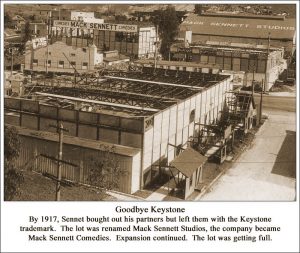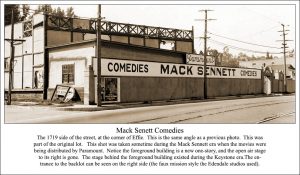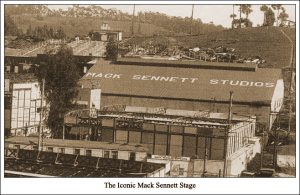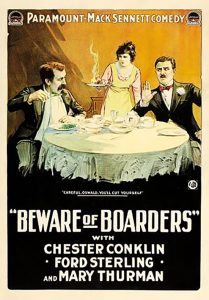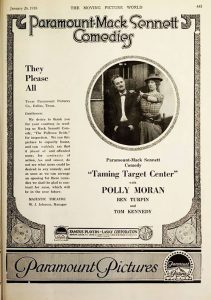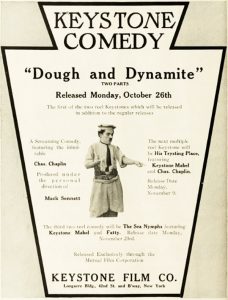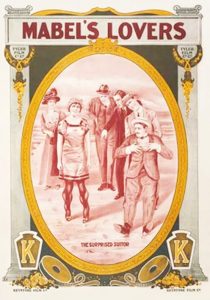1712 and 1719 Allesandro St.
Edendales's 2nd movie studio.
Photo courtesy of Marc Wanamaker / Bison Archives click to enlarge

New York Motion Picture Company
Bison Studio
aka 101 Bison Films
1712 and 1719 Allesandro St.
Active 1909-1912
Bison was a unit of Adam Kessel and Charles O. Baumann's New York Motion Picture Company. Established in 1908 in Fort Lee, New Jersey, they sent small-time producer Charles K. French to the west coast to establish California's second-ever movie studio. Originally called "Broncho" later that year management was taken over by Fred Balshofer who renamed the unit "Bison." Balshoffer would have a significant career with several companies and owning his own studios.
The studio stood on Allesandro St. between Effie and Aaron streets spanning both sides of Allesandro. It consisted only of an old storefront and barn on the east side (at 1712 Allesandro) and a 3-room bungalow on the west side (at 1719 Allesandro). The company erected a small stage on the west side of Allesandro turning the bungalow into dressing rooms. There they begin their filming. The storefront across the street became the company offices and film lab. In late 1909 or early 1910, they built another stage behind the office out by the barn.
Thomas Ince's first foray into movie making.
Thomas Ince would become a major producer in the movie industry. His legacy is as great as that of D.W. Griffith, Cecil B. DeMille, David O. Selznick, or Samuel Goldwyn. Had he not died at an early age, he might have been regarded as the greatest producer of all time.
But he started here, in Edendale, at the small Bison Studio.
NYMPC partnered with fledgling director Thomas Ince to take over the Edendale studio in roughly 1911 from Balshofer, who would continue in the business and have a long, prosperous career.
Ince renamed the unit Bison.
Ince made only a handful of western shorts here in Edendale before talking Kessel and Bauman into leasing more than 400 acres and moving his Bison unit to Santa Ynez Canyon along the Pacific Ocean. Later Ince would buy it becoming known as "Inceville."
The very brief Universal era at the lot.
The Universal Film Co (yes, the very same NBCUniversal we know today), began its life as a merger of half a dozen small movie studios, one of which included Kessel and Bauman's New York Motion Picture Company, including its assets, one of which was this tiny 2.5-acre lot and the Bison unit that sat on it. Baumann was elected president of the new company, but a power struggle ensued and Carl Laemmle grabbed control, returning NYMPC and the Bison lot to Baumann. Laemmle went on to a long career as the head of Universal. Kessel and Bauman formed a new enterprise, KayBee Pictures, and continued to have some intermittent success in the business.
Sennett takes over.
Ince had already departed and the lot was fallow. Kessel and Bauman entered into a partnership with a struggling director, Mack Sennett, and Sennett's Keystone Comedies moved into the tiny facility in 1912.
active 1912-1917
Mack Sennett Moves West
After an inauspicious start as an actor and director in Fort Lee New Jersey, Sennett moves his Keystone Comedies to the west coast. He arranged a partnership with Kessel and Baumann and moved into the old Bison lot and arrived in Edendale on August 28, 1912, with his leading lady, Mabel Normand, and began what would be one of the most successful movie enterprises of the Silent Era.
Sennett moved into the five-acre lot once occupied by Thomas Ince and abandoned by Universal, where he began to shoot his Keystone Comedies. In May of 1915, needing additional stage space, he expanded across the street to occupy five acres and built the first fully self-contained, state of the art movie studio in history (see the map view). At the same time, he formed a partnership with D.W. Griffith and Thomas Ince, which also included Baumann and Kessel and former Mutual president, Harry Aitken, to form Triangle Pictures, a new releasing company that would distribute the movies of the three big producers.
In July of 1917, Sennett separated himself from Triangle and NYMPC. Kessel and Baumann would retain Sennett's long time Keystone moniker and Sennett would come into full ownership of his studio. Fully independent, Sennett renamed his company Mack Sennett Comedies and continued his expansion and success, and found a new releasing company in Paramount Pictures.
click to enlarge
click to enlarge

Mack Sennett Studios
Active 1917-1928
By 1917 Sennett was becoming displeased with his relationship with Kessel and Baumann. He (and NYMPC had entered into a relationship with DW Griffith and Thomas Ince, called Triangle, for the purposes of releasing the pictures of the three. This new company was based at Thomas Ince's new studio in Culver City (which later became the iconic M-G-M Studios). Sennett based his company there, but Triangle struggled to make a profit, so Sennett quit the new venture and retreated back to the safety of Edendale.
Sennett bought out his partners in Keystone, leaving them with the Keystone trademark, and rebranding his company as Mack Sennett Comedies, and the studio became Mack Sennett Studios.
He had already acquired the 2.5 acre Bison lot and expanded the studio to its new 32-acre footprint. He continued to expand, building additional buildings and stages. He even leased the old Selig lot up the block, providing studio space for his old friend Roscoe Arbuckle's Comique Comedies. For a while he even leased the defunct Balboa Studios, in Long Beach, for overflow production.
Profits were up, but Sennett was not a good money manager and a poor businessman. He had a tendency to spend without limit, make loans to his friends out of the company accounts, and make bad oil, real estate, and stock investments. So while the company seemed to flourish, he was actually running it into the ground without even realizing it.
Production continued to grow at a faster and faster pace. The public seemed to love his product, and he was a master of the comedy craft. His product was being released through Adolph Zukor's Paramount Pictures, a relationship that was very good for both companies.
There came a point when his 5 acres were simply too small to meet his increasing production needs.
In 1927 he began construction of a new, much larger studio across town in Studio City and moved in 1928 shutting down his Edendale plant. He started with two very large sound stages, preparing for the sound era, an administration building, and a huge backlot. He had enough space to expand for yearsl but fate would intervene.
However by the beginning of the 1930s money was running out. He made a bad real estate investment called Hollywoodland (the only thing remaining of this project is the iconic Hollywood sign), and suffered losses in the stock market crash in 1929. In 1933 he filed for bankruptcy and the studios went into receivership.
Key Dates for this studio
- NYMPC locates Bison 101 here.
- Sennett takes over and occupies from 1912-1927.
- Between 1912 and 1915 Sennett's Keystone brand was based at the small 2.5 acre Bison lot at 1712 Allesandro
- In 1915 he expands to to three corners the Allesandro and Effie junction giing him a total of approximately 6 acres (See maps).
- From 1912-1917 Sennett was partnered with Kessel and through Baumann under the brand of Sennett's Keystone Comedies. From 1917-1927 the company was called Mack Sennett Comedies,
- Sennett closed this studio in 1927 and moved the company to a much larger Studio City lot, which he opened in 1928.
- In 1933 Sennett declared bankruptcy and folded and liquidated the company assets.
















